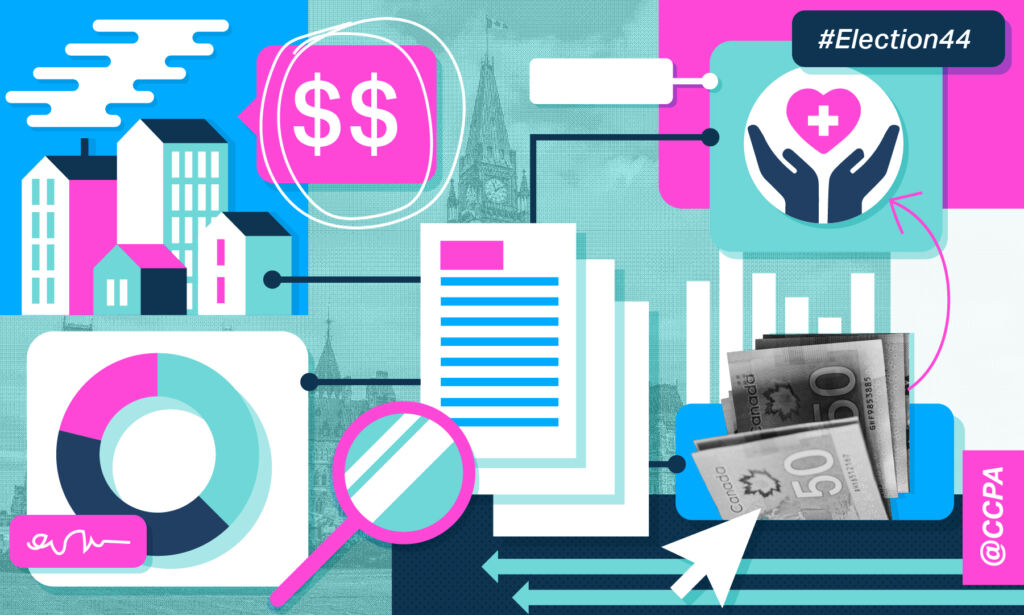Less than three weeks until election day and the Liberals have released their full platform, with a focus on COVID-19 measures, health care, economic resilience, housing, climate change, and Indigenous reconciliation.
The platform promises $78 billion in new spending over five years and is costed (although not fully), in comparison to the NDP and Conservative platforms, which rely on the Parliamentary Budget Officer to review their plans.
(See our assessment of the NDP and CPC commitments, as part of our ongoing non-partisan analysis of party platforms.)
The Liberal plan includes both new and many previously announced platform planks, such as a national child care plan, funding for long-term care and programs aimed at addressing the cost of housing.
New items in the platform include: a mental health transfer to the provinces, a new minimum 15% tax on high earners, a proposal to allow new parents with student loans to pause them, a new law protecting abortion access, new EI measures for the self-employed, extending the Canada Recovery Hiring Program, and $400 million over four years in additional funding for CBC/Radio-Canada.
Generally speaking, however, the platform articulates a continuation of an agenda that the Liberals had already begun while presiding over a minority government.
COVID-19 response
On page 10 of the platform, the Liberals take the opportunity to list everything they did as a minority government (working with the other parties—in many cases, specifically the NDP) to confront the pandemic in the last 1.5 years—including income supports to workers and businesses hard hit by the economic shutdown, Safe Restart funding agreements that flowed to provinces and municipalities, and a successful vaccination procurement plan.
The platform announcement was framed within the goal of “finishing the fight” against the pandemic, although the majority of the proposed measures have already been announced.
Generally speaking, however, the platform articulates a continuation of an agenda that the Liberals had already begun while presiding over a minority government.
The plan pledges to “get the job done on vaccines” and touts a previously announced plan to mandate vaccines on interprovincial trains, commercial flights, cruise ships, and across the federal public service. In the platform document, the Liberals take aim at the Conservative Party, which wouldn’t require vaccination but would require unvaccinated public servants to take daily rapid COVID-19 tests and unvaccinated plane and train passengers would have to take a rapid test before boarding. The NDP has come out in favour of requiring vaccines for federal workers, as well as domestic vaccine passports.
The Liberal platform pledges to launch a $1 billion fund, announced earlier in the campaign, to support provinces and territories that implement proof of vaccination requirements. It also promises to table legislation to protect businesses and organizations that decide to require proof from legal challenges.
The plan details investments in COVID-19 research (like the other parties’ plans) and “free COVID-19 vaccine boosters” as needed, although the sitting government has been negotiating booster procurement since early spring. Given concerns about vaccine nationalism, where rich countries such as Canada move on to COVID-19 booster shots as many parts of the world await their first round of vaccines, it’s important to note the Liberal platform promises to donate at least 200 million vaccine does to vulnerable populations around the world through COVAX by the end of 2022. Comparatively, the NDP promises to support the Trade-Related Aspects of Intellectual Property Rights Waiver (TRIPS), which would waive intellectual property rights for COVID-19 vaccines and ensure the required technology transfer so low-income countries can make vaccines locally.
New COVID-19-related promises include funding to provinces to improve air ventilation in schools, which is critical given that the Delta variant is considered to be airborne, and investments in mental health for those disproportionately affected by COVID-19.
Care economy
We’ve written about the parties’ child care platforms elsewhere, but there aren’t any surprises in the Liberal platform on this file. If re-elected, they would: cut child care fees in half in 2022, deliver $10-a-day child care within five years, build 250,000 new child care spaces (although it’s not clear if those will be public spaces), hire 40,000 more early childhood educators, and finalize agreements with remaining provinces and territories. These investments will help to boost critical capacity in child care services and women’s sustained engagement in paid employment while generating revenues to spur Canada’s economic recovery. Once we’re down to $10 a day, the savings for parents would be substantial, as we’ve examined previously.
The Liberal Party is also pledging large-scale investments in health care through a series of conditional transfers to the provinces and territories: $6 billion to reduce health system wait times in 2021-22 (on top of the $4 billion in one-time spending promised in Budget 2021) and another $3.2 billion over four years for the hiring of 7,500 new family doctors, nurses and nurse practitioners. $4.5 billion is being targeted to mental health services plus an additional $500 million for student services and $1.4 billion to co-develop an Indigenous mental health strategy.
The Liberals are promising to introduce new federal legislation “to ensure that seniors are guaranteed the care they deserve,” along with $9 billion in targeted investments over five years to expand the number and quality of long-term care beds, train up to 50,000 new personal support workers, and boost wages among these workers to at least $25 per hour.
A distinctions-based, community-led, Indigenous Long-term and Continuing Care Framework would be co-developed. The investment in the care workforce, in particular, is essential to turning around Canada’s flawed system of support for seniors and people with disabilities. The party is proposing to strengthen penalties for provinces that enable extra billing for publicly insured health services, but there is no mention of the imperative to end support for privatization and the reliance on for-profit providers in the care economy.
There are a few new proposals to support families in this platform, including investments to speed up processing times for family reunification and to support families pursuing in vitro fertilization and adoption. The Liberal Party is also proposing to convert the old non-refundable Canada Caregiver Credit into a refundable, tax-free Canada Caregiver Credit that will deliver up to $1,250 per year to eligible families. This measure will provide much broader support to all families shouldering significant caregiving responsibilities than the current program and the Canada Seniors Care Benefit being proposed by the Conservative Party.
The platform concludes with a disability statement promising to re-introduce and implement the Canada Disability Benefit Act, creating a direct monthly payment for low-income Canadians with disabilities ages 18-64, and to move forward with a “robust” employment strategy and the timely implementation of the Accessible Canada Act. There are no additional funds attached to these initiatives. The disability community will be awaiting speedy results, having endured the brunt of the pandemic and still vulnerable to illness and poverty as the pandemic continues.
Climate emergency
When it comes to climate policy, the Liberals build on their work in government over the past six years.
To date, those policies have been both unprecedented and inadequate, which is to say that the Liberals’ climate plans wildly surpass all previous federal efforts to reduce greenhouse gas emissions and yet have fallen short of actually reducing emissions in line with Canada’s targets.
In this new platform, the Liberals commit to doubling down on their current approach. They promise a higher carbon price, more money for green infrastructure, more subsidies for clean tech manufacturing, more incentives for consumer energy efficiency and greater attention paid to climate adaptation and nature conservation.
However, there is little new money for these initiatives beyond what was included in Budget 2021, which falls short of the public investment needed for a rapid transformation of the economy away from fossil fuels.
The elephant in the room, which all parties continue to avoid, is what to do about the oil and gas industry, which accounts for more than a quarter of Canada’s emissions.
One important running thread in the platform is an emphasis on creating green jobs and training people to do them. The Liberals recommit to introducing just transition legislation while recruiting more people from underrepresented groups for careers in the clean economy. This is a win-win approach to building a more sustainable and inclusive economy, although, like many campaign promises, the details will matter.
The elephant in the room, which all parties continue to avoid, is what to do about the oil and gas industry, which accounts for more than a quarter of Canada’s emissions. The Liberals propose to end fossil fuel subsidies by 2023 while imposing a new regulatory cap on oil and gas emissions, which at least acknowledges the problem, but falls far short of actively winding down production. The Liberals seem content with Canada producing (slightly cleaner) fossil fuels well into the future, even as the International Energy Agency warns of huge declines in global demand.
On the whole, there is no doubt the Liberals have put together a serious, evidence-based climate plan and it’s more comprehensive than the other parties’ platforms to date. The lingering question is whether their incrementalist approach can solve a climate crisis that demands urgent, transformative action.
Support for workers
Support for workers was the second largest area of support during the pandemic, just after support for businesses. The pandemic illustrated how ill-prepared the old Employment Insurance (EI) system was to manage mass unemployment. The old rules were also substantially improved to deal with the layoffs from the pandemic. However, that is all set to end on October 27, when Canada will largely return to the old EI rules, with the exception of a universal, relatively low entrance requirement of 420 hours. But the replacement rate will drop to 55%, the number of eligibility weeks for benefits will plummet, self-employed and gig workers will lose all support, and there will be no new fundamental contributions from the federal government.
The Liberal platform commits to a new CRA-run EI system for the self-employed. There is a cost to the program, but no real plan on how you make the self-employed contribute to it. Hypothetically, contributions could cover benefits. It couldn’t be voluntary because no one would sign up (that’s the case with parental EI benefits anyway). It’s an interesting new contribution, but an undeveloped commitment.
The Liberals also commit to end the misclassification of workers as “self-employed” if they, for instance, are using an app to perform gig work. If employers declare their workers “self-employed” then they don’t have to pay EI/CPP, but those employees are ineligible for those programs if they get laid off. This isn’t a new problem and this platform commitment should have been implemented five years ago. There is also a new career insurance benefit being proposed: if you’re in a job for five years and get laid off and you run out of regular EI benefits, you can qualify for additional EI payments.
There is still plenty more to do on EI, but committing to include the self-employed is new for the Liberals. The bigger questions about how adequate EI benefits remain unresolved: how are they funded and how long do they last?
Housing
Affordable housing is shaping up to be a core issue in this election. The Liberal platform devotes a great deal of attention to it, and includes measures that draw on current research and debate in the field. The party’s policy wonks seem to be listening, but the question is whether the many proposed measures amount to a substantive response to the country’s housing crisis. In our view, they don’t and, in fairness, neither do the other parties’ platforms.
The Liberal platform includes a number of measures aimed at assisting first-time home buyers. These include a rent-to-own program, a tax-free first home savings account, the doubling of the first-time home buyer’s tax credit, shared-equity mortgage options, the reduction of mortgage insurance premiums, and increasing the insured mortgage cut-off. These measures can help some families to get through the last mile of the housing ownership race. The problem is, most tenant families are nowhere near that last mile.
Take rent-to-own plans, for example. They allow buyers to lock in a property early, carefully negotiate a mortgage, and save a bit on the down payment. In today’s housing market, given how much is needed for a down payment on average homes, rent-to-own plans are not a deal-maker. They’re at best a final push, for some. The vast majority of tenant families will never qualify for such a program.
These measures can help some families to get through the last mile of the housing ownership race. The problem is, most tenant families are nowhere near that last mile.
The tax-free savings account is another example. It purportedly combines features of an RRSP and a TFSA to help families afford a down payment faster—which begs the question, do renters currently use those accounts? Most don’t. According to the most recent data available, 70% of tenant households have zero dollars in the TFSAs; 75% have zero dollars in RRSPs. The savings instrument doesn’t seem to be the problem as much as the lack of money to put in it.
Measures focused on first-time home buyers are likely to simply add to Canada’s long list of boutique housing programs that give a hand up to upper-middle-income families while doing nothing for low- and moderate-income renters.
Like the Conservative’s platform, a set of Liberal proposals focus on corruption activities and foreigner speculation, which are worth pursuing but are unlikely to have a notable impact on housing prices, especially since some provinces are already dealing with the foreigner ownership question.
On the regulatory front, the Liberal platform also promises to ban bidding wars—a long overdue policy—and to curb flipping within a 12-month period. The latter could also be a step in the right direction if it was stricter. Given the measure includes exceptions for “changes in life circumstances,” a longer cooling period (say, three years) would ensure the policy meets its stated objective.
Finally, the platform mentions the need to stop “renovictions” and review the tax treatment of Real Estate Investment Trusts (REITs), although details are missing, and they matter a great deal. The proposed surtax on “renovictions” may not have any impact if applied only on the first year following the flip because landlords will stand to gain from the flip in the following years. In regards to REITs, the platform notably uses cautious language (“review”), without mentioning any timeline or targets.
In sum, the housing platform includes many measures that will likely benefit only a small share of the population. Some are positive, but most are targeted measures. And some are promising commitments cloaked in vague language at this point. This is not a substantive plan to tackle the country’s housing crisis.
CBC/Radio-Canada
The Liberal platform promises to provide $400 million over four years to the CBC/Radio-Canada with the goal of eliminating advertising in news and public affairs programming. It also commits to increasing production of national and local news, as well as updating the broadcaster’s mandate to ensure it aligns with Canadian audience needs and is distinguishable from private broadcasters.
Meanwhile, the NDP have committed to boosting CBC/Radio-Canada funding by an unspecified amount to help “reverse the damage of decades of funding cuts.”
By comparison, the Conservative platform has pledged to “review the mandate of CBC English Television, CBC News Network and CBC English online news to assess the viability of refocusing the service on a public interest model like that of PBS in the United States, ensuring that it no longer competes with private Canadian broadcasts and digital providers.”
Taxation
It’s worth noting that the Liberal platform is the only one to date with detailed costing. New Liberal taxes offset roughly a third of new expenditures in the platform.
Our Alternative Federal Budget has long advocated for higher corporate income taxes to fund much-needed public services. Canada’s record-low rates are simply giving the corporate sector a free ride that hasn’t gone to increased investments—it’s gone to higher shareholder payouts and soaring executive bonuses.
The new 3% surtax on banks and insurance companies would do just that and possibly opens up the door to raising rates generally.
The Recovery Dividend, which seems like a fairly permanent additional tax on banks and insurers, seems to push that rate up even further. Differential tax rates by industry are not without precedent (for example, manufacturers and processors have been paying a lower rate for years).
It's too bad that the general CIT rate didn’t go up by 3%. As a refresher, only companies making profits pay corporate taxes, so a higher rate doesn’t harm struggling industries. Banks do make a good target, as they tend to pay closer to the statutory rate than other industries that use a variety of tactics to avoid taxation.
The next two bigger tax measures include a reduction in the personal tax gap and a minimum tax rule for top earners. Both of these would be pretty progressive.
Hiring more auditors at Canada Revenue Agency (CRA) (“closing the tax gap”) would yield about $4.7 billion a year in 2025-26 alone.
Most of these auditors would go after high-income earners to make sure they are paying their fair share. The almost $5 billion a year in 2025-26 in additional taxes the CRA would gain does seem a bit high. There is no doubt this strategy of hiring more staff at CRA has yielded dividends in the past. Hopefully it continues.
The minimum income tax of 15% is exclusively for high earners. The way it would work is that if you have a high pre-tax income but through accounting games come up with massive deductions thereby reducing your taxable income to zero, then you still have to pay 15% income tax on your pre-tax income, in essence ignoring the accounting games. It's only high earners with various income types that can do this anyway and they’d be the ones paying this minimum income tax.
It may come as a surprise that there currently is no federal vaping excise tax. The framework for creating one was actually part of the April 2021 budget and so it appears in the platform.
The flipping tax is discussed briefly in the housing section of this analysis. However, given the very low revenue that it is expected to generate, this means the anti-flipping tax rate that would be charged under this plan would be pretty high—so high that most flippers will work hard to avoid it by holding their properties for over a year, and therefore keeping government revenue from this new tax low.
If we actually saw the closure of flow-through shares, it would frankly be a miracle. The promised closure of this tax loophole, which basically subsidizes the search for new oil, gas and coal has been a perennial one. It should have been closed years ago as an ongoing subsidy to oil and gas.
Despite costing very little, the platform proposes an expansion of the Educator School Supply Tax Credit. This is a boutique tax credit in which teachers can claim some of the things they buy for their classrooms back on their taxes. It amounts to almost nothing in terms of a refund, it complicates the tax code, and it should be cancelled, not expanded, so as to put the boutique tax credit era to an end.
As a final point, it's important that Canada continue modernizing its corporate tax system to stop tax avoidance that has become endemic among large multinational corporations. If companies never declare profits in Canada because they’ve shifted them elsewhere, it doesn’t matter what the tax rate is. A global minimum tax, committed to in the Liberal platform, is an important means of getting around the accounting games. It would mean that no matter where you say the profits emerge, companies can’t avoid a 15% corporate tax. The OECD has been making important moves in the right direction. However, countries like Canada may eventually have to put their foot down irrespective of that process and impose restrictions unilaterally at first, although that is certainly not what is being proposed.
Fiscal considerations
So far in this election, the Liberal platform is the only one that is costed (although not fully). The Conservative Party and NDP are relying on the Parliamentary Budget Officer to cost their platforms—a service that began in 2019. Before 2019, parties were expected to do their own platform costing. It may not have been perfect, but the thing about program costing, which the CCPA has learned from many years with our Alternative Federal Budget, is that program proposals become more specific and we’d recommend that all parties release fully costed platforms in the future.
With the proviso that the cost of other parties’ platforms can’t be compared because they haven’t yet done the math, the Liberal platform would add additional net expenditures, although they would be offset, to some degree, by some new taxes (discussed above).
Interestingly, there is a new “risk adjustment for COVID prudence” of $6 billion a year for two years. It’s interesting given this common practice of including a prudence budget line was not included in the April 2021 budget. There was plenty of uncertainty then as well.
In any event, the Liberal platform inadvertently illustrates that the return (or not) of economic growth is really what will drive deficits in years to come, not government spending.
The debt-to-GDP ratio projection is lower in the platform than the spring 2021 budget because the economic baseline is better now. The platform is using the PBO’s August estimates of economic growth, which are more optimistic than those in the April 2021 federal budget. These changed assumptions result in the deficit projection being $18 billion lower in 2022-23, based on growth assumptions alone. Although who knows if that more optimistic analysis will materialize after the abysmal Q2 GDP contraction.
In any event, the Liberal platform inadvertently illustrates that the return (or not) of economic growth is really what will drive deficits in years to come, not government spending. Rapidly picking up economic growth again will be critical to the federal government in the years to come. One of the important ways to do that is through government investment.
Reconciliation
While in government, the Liberals have spoken about the need for reconciliation with Indigenous Peoples but it’s been a bumpy ride and there is growing impatience over inaction. In their platform, the Liberals promise the following key actions, among others:
To work with Indigenous partners to appoint a special interlocutor “to develop a legal and regulatory framework to advance justice regarding unmarked graves” and to support communities that want to undertake burial searches at former residential schools;
To eliminate all clean long-term drinking water advisories;
To confront systemic racism against Indigenous Peoples in the justice system and health care;
And to launch an Indigenous housing strategy.
Like the NDP platform, the Liberals devote considerable space to address Indigenous issues as part of what’s necessary for Canada to truly act on truth and reconciliation. While much of the Conservative’s Indigenous commitments focus on the economy and resources—including passing legislation to make it illegal for protestors to block infrastructure, such as rail blockades, which could adversely impact Indigenous Peoples—they do make a commitment to fund an investigation of all former residential schools where unmarked graves may exist, as well as to developing a plan to implement some of the Truth and Reconciliation Commision’s Calls to Action.
Conclusion
Many people questioned the need for a federal election just two years after the previous one, and one during a pandemic. The Liberals responded that this would be Canadians’ chance to weigh in on the pandemic and post-pandemic direction of this country. The Liberal platform is essentially a continuation of what the party was doing under a minority government situation. In some cases, that means making promises that they still haven’t made good on; in other cases, it means an expansion of the work they’d already begun. It’s a “no new surprises” type of platform.

















